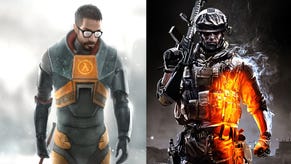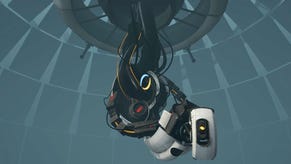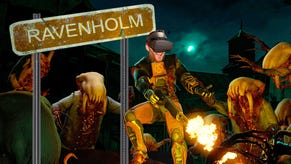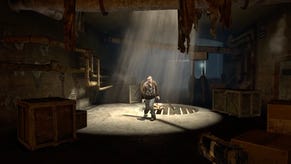E3 2003: Half-Life 2
Three words: Oh. My. God.
We know the exclusive presentation has now leaked out onto the net, but any game that makes us physically shake with excitement deserves some measure of evangelism nevertheless. With Half Life 2, Valve has taken the FPS by the scruff of the neck, whirled it around its head, and drop kicked its sorry arse into another dimension. The five years of quiet hype-free development have positioned the US team so far ahead of the competition it's almost embarrassing. Better than Doom III and Halo 2? Yep. But how?
Sourcey
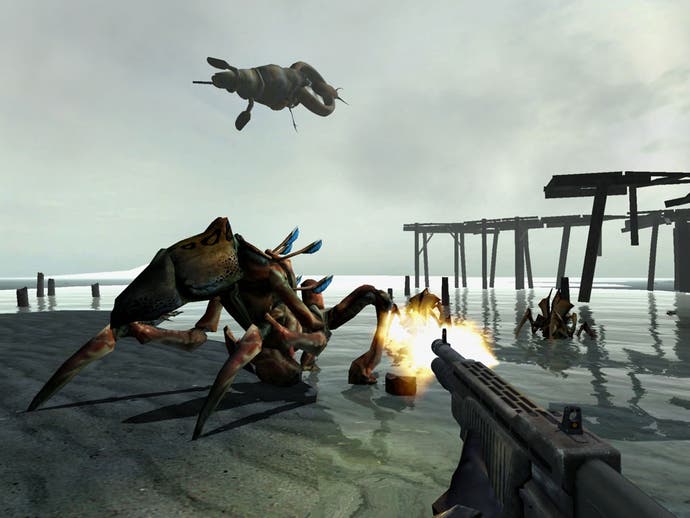
Simply put, the breathtaking scope of Valve's Source engine has allowed the team to do things in their game that rival developers have probably not even dared to speculate that they could do. But before we get too wound up with gushing enthusiasm, allow us to give you some idea of what's in store and just why it's such a quantum leap for the industry.
Taking one of only thirty seats in ATI's tiny auditorium, we positioned ourselves smack in front of one of the two delicious high definition widescreen TVs that displayed such a fantastic picture we simply have to own one of these as soon as humanly possible. Valve founder Gabe Newell sat at the front on the presentation, and read a pre-scripted speech out, probably for the 17th time since the show began, but you could sense the man was only too happy to run through it all again to see the awestruck faces in front of him. During the gameplay footage, we clocked Newell checking out the reaction, and he had every right to feel good about the series of shaking heads and open mouths before him. This was history in the making.
The 20 minute presentation kicked off with a quick overview of the inordinately impressive Source engine's capabilities. Screenshots and tiny QuickTime teaser trailers cannot hope to do justice to seeing the game in the flesh on a giant monitor with full surround sound. We've read a few forum posters muttering that they're not that impressed with the graphics ("They're good, but not that good", for example), but in some ways they’re even more appealing than Doom III's - maybe not in terms of character models, but certainly in terms of believable and appealing environments, replete with outstanding incidental touches at every single turn.
Talk the talk
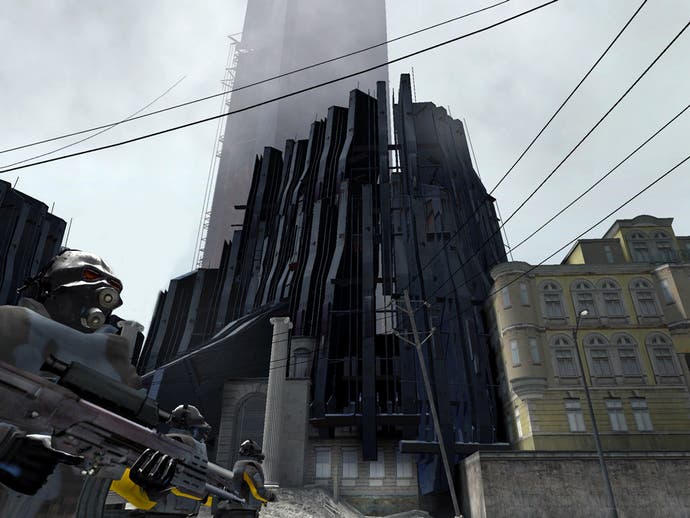
The infamous G-man was the first thing to be shown off, and Newell explained that the facial animation involves manipulating forty separate 'muscles', with the same system responsible for both emotion and speech. To demonstrate the flexibility, Newell showed off the G-Man speaking in Chinese, with the system completely language independent. Later showings of Al certainly proved the point that this is easily the most impressive lip synching, facial expression system around. The detail and level of expression has to be seen to be believed, and makes current solutions look instantly old hat.
Newell moved onto the environmental capabilities within the game, with the demo showing some stunning displacement that allows the world to be fundamentally changed dynamically, with the ground capable of morphing into seemingly whatever state the developer dictates. As you'll have read, or seen if you're lucky, the ability for the player to manipulate objects and material in the world allows for some interesting gameplay possibilities. Every object in the game has a physical property, ably demonstrated with the destruction of a wooden structure, the impact of objects on others, as well as some impressive rag doll physics that rewrite the rule book. As Newell points out, there are no arbitrary restrictions in your environment, and the bewildering array of ways of affecting everything around you makes for an incredibly visually arresting experience.
Progressing through the presentation, we finally got to see the results of this technical accomplishment in terms of gameplay. After a brief crowbar encounter with some zombies, one of which end up face down floating in the water, we're off to an underground environment, where the combat forces have apparently driven Freeman underground, and we're shown a sequence with a trio of relentless flying alien drones buzzing after you. After some ducking and diving, with barrels and all manner of debris being knocked about all over the place, you finally shut off a posse of these pesky beings by shutting a gate in their enraged faces. But instead of giving up, they continue to grind up against the metal structure while you proceed to take on some military types - one of which you send plummeting to their doom by shooting out the railings.
Walk the walk

Upon meeting up with your lovely sidekick Al, a hapless soldier is dragged into a pool by an unseen blue tentacled creature, saving our heroes from being shot in the head, ironically. It was these consistent set pieces that made the original Half Life's narrative so subtly compelling - the difference with the sequel is that the game seems to be one giant cut scene. Scripted they may be, but the action sequences just roll into one another and it's exhilarating just watching the events unfold.
After a few encounters with some military personnel (why they're attacking you isn't exactly clear), and some sentry gun destruction, the action moves into a curious territory where you're able to use alien technology against your aggressors. Rather like a more devastating version of the 'Snarks' in the original, Freeman is able to arm himself with spawning alien 'pods' which give birth to hideous giant insectoids which attack anything you command them to - even the vicious tripod sentry guns. By using them as a makeshift shield, the demo shows Freeman ducking into a side room and taking them out by knocking them over, leaving them firing wildly into the nearest wall before finally spluttering to a halt. [Upon further inspection of the videos we've seen, it's actually now clear that the pods contain pheremones which attract the beasts from outside, with them emerging from holes in the ground, through windows, etc -Martin]
Next up is a section that shows off Freeman at the wheel of a nimble ATV, which is also armed with a machine gun. The speed of the engine at this point is certainly well up to scratch with any racing game out there, and offers an ample demonstration of the flexibility of the Source engine. Once out of the ATV, Freeman has to fend off the attentions of a ferocious trigger happy flying machine. Ducking the relentless laser fire behind some wrecked cars, the physics within the game is demonstrated once again, with the incoming fire serving only to dislodge the cars from their resting place. Once the ship is finally destroyed, its impact sends the wrecks flying in an impressive mass of twisted metal.
And er, stride the stride
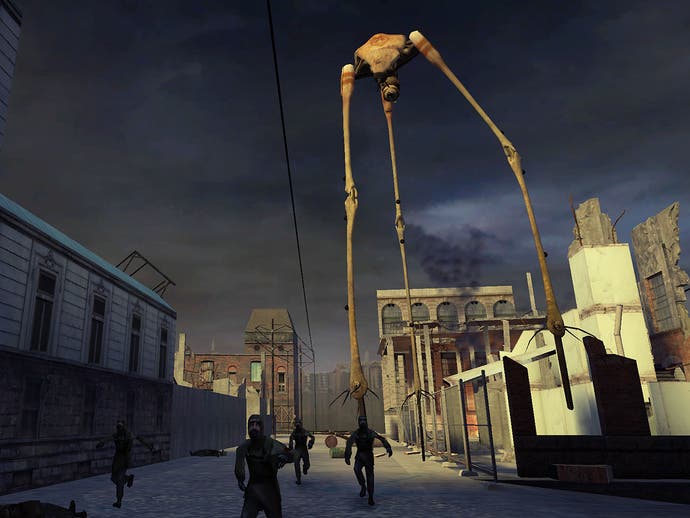
With our senses frazzled enough already, the final stage of the gameplay demonstration moves the action up a further notch with the arrival of the spindly legged Striders. In what looks like a videogame interpretation of War Of The Worlds, we see a war ravaged Eastern European city, with a series of elegantly designed buildings reduced to rubble, presumably as a result of the as-yet-unexplained alien invasion.
A gaggle of terrified individuals run screaming from a cloud of smoke, and at last we get to see these giant creatures of doom that are running amok around the once pretty town.
Not only do the powerful Striders tower fully 90 feet into the sky, they're aimed with a particularly deadly pulse laser which seems to have the effect of warping the very fabric of existence around it when charged up. Faced with a small archway construction which the Strider cannot negotiate, the fearsome foe blasts it to smithereens, while the feeble humans run for cover wherever they can, but for one poor unfortunate, it's too late. He ends up being skewered by one of the Strider's legs. Ouch. Much laser fire ensues... this is almost too much to take.
Before we ended up having a heart attack with the excitement, the action cuts to the G-Man. "Well, well. Isn't this just like old times?"




